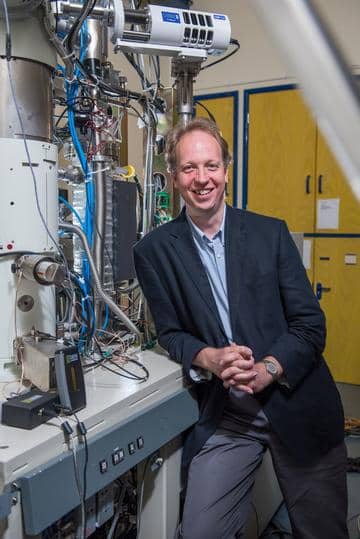Seeing is Believing with Professor Peter Nellist
On Tuesday 2nd May Professor Peter Nellist of Corpus Christi, Oxford, came to speak to pupils about his work developing high-resolution electron microscope techniques. His talk, entitled, ‘Seeing is Believing: how seeing atoms in the electron microscope helps develop the materials of tomorrow’, provided a fascinating insight into how microscopy data can be used in a quantitative way to make measurements of the atomic and electronic structure of materials.
Lower Sixth pupils Isobel Howell and Yuki Watanabe tell us more:

Professor Peter Nellist © John Cairns
Similar to many scientific fields, Materials Science has been developing rapidly over recent years. One of the most revolutionary contributions to the field is the ability to visualise atoms. When we can see atoms, we can decipher why materials behave the way they do. The first electron microscope was created in the early 1930s and this analytical technique has been being developed ever since. Professor Nellist himself has contributed greatly to improving the resolution of these microscopes which has had a profound effect on how we view materials.
Professor Nellist showed us a paper clip, and then proceeded to bend it. Why did it bend? As any IGCSE chemist would know, the layers of the metal structure slide over each other. This would be a correct assumption, however when we think about the structure of a metal, for layers to slide over one another, all the bonds must be broken between the two sliding layers for a shift to occur, which would require a significant amount of energy. To solve this issue the Dislocation Theory arose, which although controversial at the time, theorised that defects in the metal structure would result in fewer bonds needing to be broken at one time and consequently less energy needed to slide layers of metal over one another. This theory would not have been proven without the help of an electron microscope, which enabled us to see the dislocations in the metal, and how they act when a metal is bent. This is just one example of how such as powerful microscope has contributed to our understanding of materials.
Another compelling anecdote that Professor Nellist mentioned involved a PhD student making use of a carbon nanotube with fullerene to deliver medication around the body. Hypothetically, the fullerene would act as a stopper and have a polypeptide chain attached to it, which would only get activated when it reaches the targeted tissue, minimising the side effects of the medication. The student was able to view, through the electron microscope, the faults in her project. This is a great example of just how important Materials Science is, improving numerous areas of our lives, even down to the medicine we receive.
It was such an amazing opportunity for all of us passionate about science to hear from an expert in his field with so much knowledge on the electron microscope. Not only were we stimulated by his research and knowledge, Sixth Formers were also able to gain insightful advice and opinion about UCAS applications.